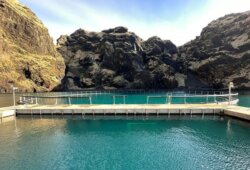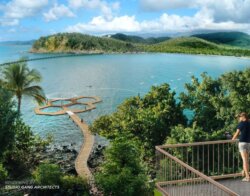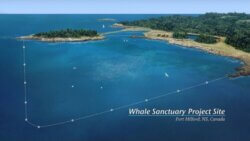Organizations work together to establish best practices
The Global Federation of Animal Sanctuaries (GFAS) has adopted and published the first ever set of best practices for cetacean (whale and dolphin) sanctuaries. (See the press statement here.)
The new guidelines are the product of a pioneering collaboration between the Whale Sanctuary Project, the National Aquarium, Sea Life Trust, and Merlin Entertainments.
Accreditation standards for sanctuaries that care for land animals – including elephants, great apes and big cats – have been in place for many years. And now, as public opinion demands an end to keeping whales and dolphins in concrete tanks for the purposes of entertainment, coastal sanctuaries are being established for their retirement.
The new standards provide the answer to a critically important question: What constitutes a true, authentic sanctuary? And how do you know that a facility that calls itself a sanctuary really is what it claims to be?
Until now, there have been no generally recognized standards for what differentiates a sanctuary from any other facility that houses whales and dolphins.
“These guidelines were established through the combined efforts of top cetacean experts,” says Valerie Taylor, executive director of GFAS, in a press statement issued this week. “They signal a defining moment for the future of captive cetaceans across the globe.”
Four questions you can ask
Dr. Lori Marino, President of the Whale Sanctuary Project and a neuroscientist with expertise in the psychology of cetaceans, explains that the new guidelines expand on four simple questions that anyone visiting a facility that houses whales and dolphins – or indeed any other kind of animal – can ask themselves:
- Does it engage in trained performances?
- Does it allow visitors to have direct contact with the animals, e.g., swim-with-dolphins programs, petting pools, etc.?
- Does it allow breeding?
- And overall, does it have any priorities other than the well-being of the animals?
If the answer to any of these questions is yes, then it isn’t an authentic sanctuary.
The fact is there are numerous facilities, all over the world, that call themselves sanctuaries in order to attract well-meaning tourists who pay to ride the animals, swim with them, and so forth. Those activities require putting the well-being of the visitors ahead of that of the animals.
“That’s why it’s so important that we have firm standards by which authentic sanctuaries can be accredited,” Dr. Marino explains.
Three aspects of an authentic sanctuary
The new standards define three aspects of an authentic sanctuary: the place where they are located, the principles on which they’re founded, and the practices by which they are governed. Each of these have to prioritize the well-being of each sanctuary resident over human interests.
Place: An authentic sanctuary sets out to approximate a natural cetacean habitat to the fullest extent possible. So, it should be located in a large, natural, coastal area that promotes diverse, natural behaviors and relationships, while conserving the natural ecosystem of the habitat itself.
Principles: At an authentic sanctuary, the welfare of cetaceans takes priority over all other considerations, including visitors, caregivers, scientists and donors.
Practices: Authentic cetacean sanctuaries provide human care (feeding, veterinary check-ups and treatment) essential for health and safety, as do traditional marine parks. Sanctuaries therefore represent the best of both worlds for captive cetaceans.
About the team that formulated the new standards
For the past two years, leaders of the National Aquarium, the Whale Sanctuary Project, and Merlin Entertainments and its sister charity Sea Life Trust have worked together to establish science-based standards that derive from their experience and their aspirations for the animals they serve.
Merlin Entertainments: Since the 1990s, Merlin Entertainments, a British company that specializes in amusement parks, has followed a policy of not having whales and dolphins at any of their facilities. So, when it took over the Changfeng Ocean World in Shanghai in 2012, it set about providing a new home for the three beluga whales who were on display there, funding and supporting the work of its partner, the nonprofit Sea Life Trust, to build a sanctuary in Icelandic waters. And while one of the whales did not survive long enough to be retired, the other two, known as Little Grey and Little White, were transferred to their new home in 2019.
“We have seen first-hand the gargantuan effort, cost and sheer amount of care and passion that these sanctuaries take to create and beyond that, to maintain,” says Rob Hicks, Global Director of Animal Welfare at Merlin Entertainments. “They are years in the making and need to be supported and run by a whole network of amazing and dedicated people.”

Sea Life Trust beluga sanctuary
Sea Life Trust is Merlin Entertainment’s nonprofit partner, working globally to protect the world’s oceans and the amazing marine life that lives within them.
The organization’s vision is of a world where our seas are healthy, protected, and full of diverse life. We own and operate marine wildlife sanctuaries, run inspiring conservation campaigns, and fund projects and education programs that champion the need for plastic-free oceans, sustainable fishing, effective Marine Protected Areas, and an end to over-exploitation of marine life.
The Whale Sanctuary Project works to transform the way people relate to whales and dolphins by bringing an end to their exploitation and by creating seaside sanctuaries, assisting with international marine mammal rescues, and advancing whale and dolphin science.
Right now, with your help, we are creating a gold-standard coastal sanctuary in Port Hilford Bay, Nova Scotia, where cetaceans (whales and dolphins) can live in an environment that maximizes well-being and autonomy and is as close as possible to their natural habitat. It is being designed to serve as a model for many more that can then be built all over the world in the coming years.
“Sanctuaries are one of the most important ways we can make reparations to these intelligent, beautiful animals for decades of exploitation,” Dr. Marino says. “That’s why we’re so gratified to be working with other experts and scientists who share the vision of a world in which no dolphins or whales are used for entertainment but are treated with the respect they deserve.”
The creation of this sanctuary is the first step toward our vision of a world in which all cetaceans are treated with respect and are no longer confined to concrete tanks in entertainment parks and aquariums.

Concept design for National Aquarium sanctuary
National Aquarium: In 2016, John Racanelli, President and CEO of the National Aquarium in Baltimore, announced the aquarium’s intention to move the dolphins in its care to an oceanside sanctuary. “As we embarked on this ground-breaking work,” he says, “we quickly determined this was about more than our dolphins alone; it concerned all captive cetaceans.”
John and his team have worked closely with the Whale Sanctuary Project and Sea Life Trust. “It was imperative that we work with other experts in the field to outline the places, principles and practices that would define authentic cetacean sanctuaries. We have a duty to the animals in our care to ensure that when they move, it is to a new home designed around their social, physical and emotional needs, one that comes as close as possible to their native habitat.”
Global Federation of Animal Sanctuaries: The Global Federation was founded in 2007 by animal protection leaders in response to what they saw in the virtually unchecked and often hidden exploitation of animals for entertainment and profit. Since then, the organization has facilitated the establishing of standards for many other kinds of sanctuaries, including for elephants, great apes, big cats and companion animals.
Executive Director Valerie Taylor looks forward to the new cetacean standards paving the way for many more whales and dolphins to be retired from entertainment facilities. “Like all authentic sanctuaries,” she says. “These ocean havens will be ‘Cetacean Welfare First,’ meaning that the animals’ wellbeing, rather than visitor experience or company profit, will always be the priority in animal care, sanctuary design and overall operations.”
The “Standards for Cetacean Sanctuaries” are published here. And the Global Federation’s press statement can be downloaded here.
